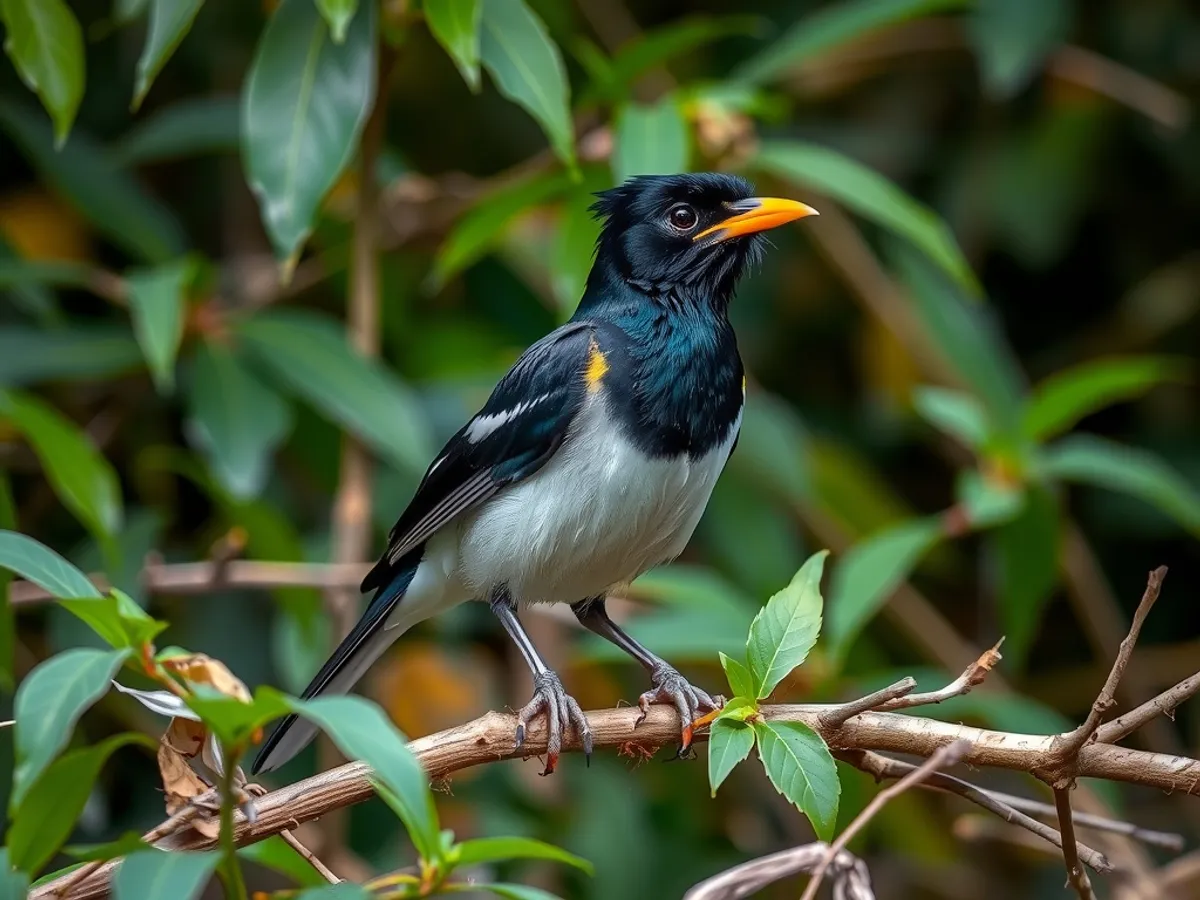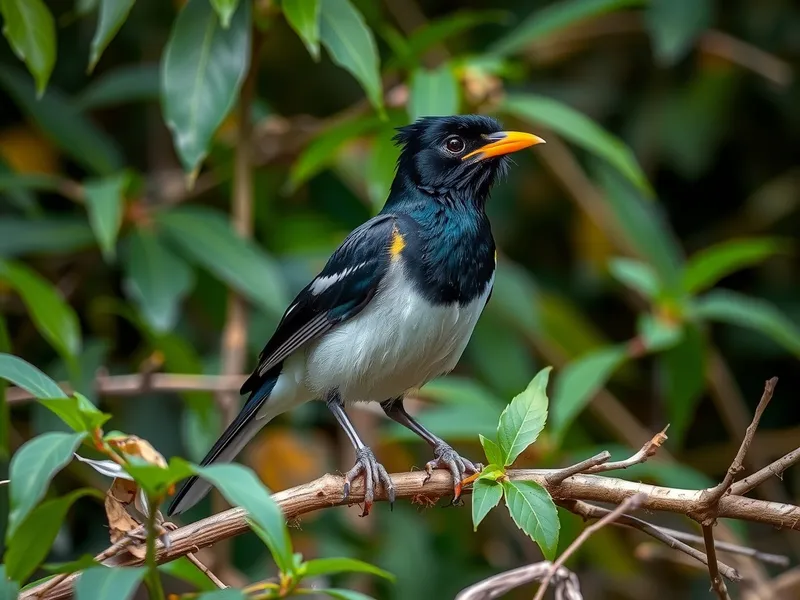
Common Myna
Acridotheres tristis

Meet the Common Myna
The Common Myna is a highly adaptable and intelligent bird native to South Asia but now found in many parts of the world due to introductions. Recognizable by its brown body, glossy black head, and distinctive yellow eye patch and legs, the myna is famous for its loud, varied calls and vocal mimicry. It thrives in urban, suburban, and agricultural environments, often seen scavenging for food in parks, gardens, and even city streets. The Common Myna is known for its aggressive behavior, especially when competing for nesting sites, sometimes displacing native species.
Classification
Bird
Habitat
Urban areas, farmlands, grasslands, and open woodlands
Diet
Omnivore
Lifespan
4-12 years
Conservation
Least Concern
Weight
100–140 g
📖Fascinating Facts
Vocal Mimicry
Common Mynas are known for their ability to mimic human speech and other environmental sounds, making them popular pets in some regions.
Global Invader
Originally from South Asia, the Common Myna has spread to Australia, the Middle East, Africa, and Pacific islands, often becoming an invasive pest.
Urban Survivor
Their adaptability allows them to thrive in cities, towns, and farmlands where they scavenge for food and nest in buildings.
📋Detailed Description
The Common Myna (Acridotheres tristis) is a medium-sized passerine bird, typically measuring 23–26 cm in length and weighing between 82–143 grams. It is characterized by a chocolate-brown body, glossy black head, and a prominent yellow patch of bare skin behind the eye, as well as bright yellow legs and bill. The wings display a distinctive white patch visible in flight, and the tail is tipped with white. Mynas are highly vocal, producing a wide repertoire of calls, whistles, squawks, and even mimicking human sounds and other species. Anatomically, they possess strong legs and feet adapted for walking and hopping on the ground, and a robust, slightly down-curved bill suited for a varied diet. Socially, Common Mynas are often seen in pairs or small groups, but can form larger communal roosts, sometimes numbering in the thousands. They are diurnal, spending much of the day foraging on the ground or perching conspicuously. Their intelligence is notable, with problem-solving abilities and adaptability to novel environments. The species is highly territorial during the breeding season, aggressively defending nesting sites against conspecifics and other birds. Their nests are typically built in cavities, including tree holes, buildings, or artificial structures, reflecting their synanthropic tendencies.
💡 Did you know?
Despite their cheerful appearance, Common Mynas aggressively evict native birds from their nests and have become a major pest in several countries.
🔬Research & Sources
Wikipedia Summary
The common myna or Indian myna, sometimes spelled mynah, is a bird in the family Sturnidae, native to Asia. An omnivorous open woodland bird with a strong territorial instinct, the common myna has adapted extremely well to urban environments.
Last Modified: 5/26/2025
🎭Behavior & Social Structure
Common Mynas exhibit complex social behaviors, including cooperative foraging and communal roosting. They are omnivorous generalists, feeding on insects, fruits, grains, human food scraps, and small vertebrates. Foraging is primarily terrestrial, with birds walking or hopping on the ground, but they will also exploit arboreal food sources. They are opportunistic feeders, often observed scavenging in urban environments and following agricultural activities to exploit disturbed insects. Aggression is common, especially during the breeding season, with pairs vigorously defending territories and nesting sites. They display a variety of threat displays, such as fluffing feathers, vocalizing, and direct physical confrontations. Daily routines typically involve early morning and late afternoon foraging, with midday periods spent resting or preening. At dusk, they gather in large communal roosts, which can be noisy and conspicuous. Social hierarchies are evident within these roosts, with dominant individuals securing preferred perches.
👶Reproduction & Life Cycle
The breeding season of the Common Myna varies geographically but generally peaks between March and August in its native range. Mynas are monogamous, forming long-term pair bonds. Courtship involves mutual preening, vocalizations, and display flights. Nests are constructed in cavities—natural or artificial—lined with twigs, leaves, feathers, and assorted debris. Clutch size ranges from 4 to 6 pale blue eggs. Both sexes participate in incubation, which lasts about 13–18 days. After hatching, both parents feed the altricial chicks, which fledge at 22–27 days old. Multiple broods may be raised in a single season, especially in favorable conditions. High reproductive output and flexible nesting habits contribute to their invasive potential in non-native regions.
🛡️Adaptations & Survival
Common Mynas possess several adaptations that facilitate their success in diverse environments. Physically, their strong, versatile bill enables them to exploit a wide range of food sources. Their robust legs and feet are adapted for terrestrial locomotion, allowing efficient foraging on the ground. Behavioral plasticity is a key adaptation; they quickly learn to exploit new resources and environments, including urban landscapes. Their ability to nest in a variety of cavities, including man-made structures, reduces dependence on natural nesting sites. Aggressive territoriality and competitive exclusion of other cavity-nesting birds enhance their breeding success. Vocal mimicry and complex communication facilitate social cohesion and territory defense. Their tolerance of human activity and ability to exploit anthropogenic food sources are significant evolutionary advantages.
📚Research Sources
🎨Cultural Significance
The Common Myna holds a prominent place in South Asian culture, often symbolizing adaptability and resourcefulness. In Indian folklore and literature, it is celebrated for its vocal abilities and intelligence. Mynas are sometimes kept as pets due to their capacity for mimicry and tameness. In some regions, they are considered auspicious, while in others, their aggressive behavior and association with crop damage have led to negative perceptions. The bird’s adaptability to urban environments has made it a familiar presence in cities, further embedding it in local culture and daily life.
🔬Recent Research & Discoveries
Recent scientific studies have focused on the Common Myna’s invasive ecology, particularly its impact on native bird communities and urban ecosystems. Research has documented its role in competitive displacement of native cavity-nesters, such as parrots and small passerines, in Australia and the Pacific. Studies on vocal communication have revealed complex call structures and context-dependent vocalizations, contributing to our understanding of avian cognition and social behavior. Genetic research is ongoing to clarify population structure and pathways of introduction in non-native ranges. Behavioral studies have highlighted the species’ problem-solving abilities and adaptability to novel challenges, making it a model organism for urban ecology and invasion biology.
🎥Wildlife Videos

Wildlife in the Garden | Common Myna | Nature Documentary 🌿
naturedocumentary #Wildlife #SriLanka #educational All about Common Mynas ( Acridotheres tristis ) - one of the many bird ...
Nature Trail | Sri Lanka

The Adaptable Life of the Common Myna
Discover the fascinating world of the Common Myna, a bird that has adapted to diverse environments and lifestyles across Asia ...
Animal Insights

Indian Myna Birds - A pest species
The Indian Myna is considered a pest which prevents our local animals from surviving or thriving in their natural habitat. Find out ...
Banyule City Council

Myna Studios: SECRET INVASION | Javan & Common Mynas
Since the 1920s... a certain myna bird has slowly infiltrated the societies of Singapore... and have begun their secret invasion!
Little Red Jungle

Amazing Myna Bird Mother: A Heartwarming Journey of Nesting and Care | Wildlife Documentary
Fascinating world of the Myna bird in this captivating wildlife documentary, "Amazing Myna Bird Mother: A Heartwarming Journey ...
EMP Animals

THE FAMILY OF COMMON MYNA || FULL DOCUMENTARY
COMMON#MYNA THE FAMILY OF COMMON MYNA || FULL DOCUMENTARY. The common myna or Indian myna (Acridotheres ...
B l u e f f y memes
🌍Habitat Information
The Common Myna typically inhabits Urban areas, farmlands, grasslands, and open woodlands environments. Common Mynas have adapted to their environments with specialized features and behaviors.
Primary Habitat:
Urban areas, farmlands, grasslands, and open woodlands
More detailed habitat information will be available soon.
🛡️Conservation Status
The Common Myna is currently classified as Least Concern. Conservation efforts are crucial for preserving this species for future generations.
Common Threats:
- 🏠Habitat loss and fragmentation
- 🌡️Climate change impacts
- 🎯Hunting and poaching
- 🏭Human-wildlife conflict
⚠️Threats & Conservation Challenges
Globally, the Common Myna is listed as Least Concern by the IUCN due to its large, expanding population and adaptability. However, in regions where it has been introduced (e.g., Australia, South Africa, Pacific Islands), it is considered an invasive species, posing threats to native biodiversity by outcompeting indigenous birds for nesting sites and food. In its native range, threats are minimal, though urbanization and habitat modification may alter local populations. Control measures in introduced areas include nest removal, trapping, and public awareness campaigns. Disease transmission (e.g., avian malaria, Newcastle disease) and pesticide exposure are potential challenges, but the species’ resilience and high reproductive rate mitigate population declines. Human persecution is rare, as the species is often tolerated or even encouraged in agricultural settings for insect control.
🔬Scientific Classification
Scientific Name
Acridotheres tristis
Classification Hierarchy
🔍 About Taxonomic Classification
Taxonomic classification is a hierarchical system used by scientists to classify and organize living organisms based on shared characteristics and evolutionary relationships.
The system moves from broad categories (Kingdom) to increasingly specific ones, with each animal's scientific name typically consisting of its Genus and species.
📝Community Notes
Share your observations and insights about the Common Myna with our community of wildlife enthusiasts.
Join Our Community
Sign in to share your observations and connect with fellow wildlife enthusiasts.
Sign In to ContributeNo community notes yet
Be the first to share your observations about the Common Myna!
Explore Common Myna
Select a tab above to learn more about this amazing animal.
📸Photo Gallery
No photos available for this animal yet.
🌟Discover More Wildlife
Continue your journey of discovery with more fascinating animals from our database
